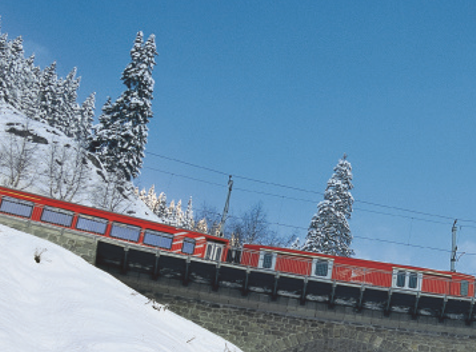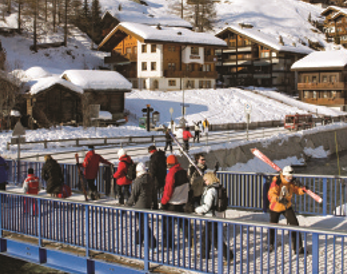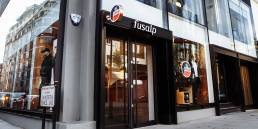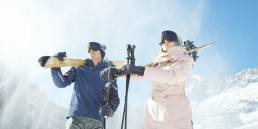The Matternorn – The Icon
The Matterhorn, And The People, The Towns And The History That Surround It.
By Roger Toll
I saw the shredded rope from the climb at Zermatt’s Matterhorn Museum last winter, along with some of the team’s primitive mountaineering gear, wool clothes, and other paraphernalia. Whymper’s account of the climb had engraved itself on my brain when I read it as a teenager, so seeing these memorabilia triggered bolts of adrenalin that never seemed to settle down during the week I spent skiing its slopes and ambling its streets. In the outsize mountain landscape that towers over Zermatt, the impressive Matterhorn Museum felt like base camp, a sort of touchstone to the origins of mountain tourism.
The Matterhorn, that soaring icon of the Alps famously emblazoned on bars of Toblerone chocolate, bestrides the Italian-Swiss border like a totem. It is hard not to be fixated by its presence as you walk around town or catch it, imposingly concrete yet strangely ineffable at once, looming outside your hotel window. With a banner cloud that never left its leeward face during my visit, the 14,692-foot peak seemed more a work of art, a monumental sculpture, than a mere mountain. Indeed, a grisly work of art, one that has taken more than 500 lives.
Ironically, that deadly conquest of its summit elicited a wave of media frenzy around the world, launching Zermatt as an international tourist destination beyond the trickle of British climbers who had been arriving since 1855, when the town’s first hotel, the Monte Rosa, was opened. Along with St. Moritz and Chamonix, Zermatt became the birthplace of mountain sports. It takes 45 minutes to reach the Klein Matterhorn via a gondola that passes through two intermediate stations where skiers can get on or of , then a steep tram to the 12,740-foot top station, the highest in Europe, recently rebranded as Matterhorn Glacier Paradise. A large restaurant and a tunnel leading into the cold belly of the Theodul glacier are two of the attractions, but I headed instead to an elevator recently installed inside the mountain that lifts visitors 200 feet to its summit, skirting a breathless slog up a long metal staircase I had climbed in ski boots a decade ago. From a panoramic platform, the vast Alpine amphitheater that cradles Zermatt presents a roiling horizon of teeth and fangs and glaciers. The views are incomparable, whether of the town 7,500 feet below, seen as if through the wrong end of a telescope, or across myriad high peaks to the majestic massif of Mont Blanc, the continent’s highest mountain, 35 miles away. Counting just the peaks directly above Zermatt, 38 soar higher than 4,000 meters — 13,123 feet — Europe’s threshold of a high peak, equivalent to our 14ers.

It was a sunny day, but cold, with hard, week-old snow. “Ideal conditions for a quick visit to Italy,” said my guide, Julia Krogull, with the insight of a local. Coming out of Klein Matterhorn, we poled across the ridgeline onto bella Italia’s south-facing slopes, carving high-speed turns in sun-softened snow all the way down to Valtournenche, deep in Italy’s Valle d’Aosta, a descent of 8,000 feet and nearly 20 miles. A gondola, two chair lifts, and a surface lift brought us back up. We dropped down for a second run in a different direction, another fun, looping route into the Italian ski town of Breuil-Cervinia. We couldn’t resist one more trip back to Cervinia, this time racing each other, and smiling all the way on largely empty slopes. In three runs, we had clocked 20,000 feet of vertical. It was time for lunch.
Bontadini Restaurant sits directly under the less-recognizable Italian face of the Matterhorn, better known on that side as Monte Cervino. One of the most beautiful mountains in the world when seen from Switzerland, the Matterhorn looked plain Jane
from the south. But the Bontadini was full of sunlight and charm, from the array of bottles of fine regional wines to the many photographs of the towering peak taken, clearly with pride, from the village of Cervinia. I chose the special-of-the-day, homemade fettuccini with a sauce of pignole nuts and fresh mushrooms harvested in the valley below, accompanied by a superb salad of fresh, lightly grilled artichoke hearts and slices of fresh parmesan cheese. Set of by a bottle of an excellent red from the valley at our feet, it was a simple but memorable meal, and so pleasurable that as we walked to our skis, Monte Cervino was now looking even more beautiful than I had seen it from the Swiss side.
The town of Zermatt is storybook pretty, of course. Vail, but the real thing. Plan to walk a lot, or alternately catch a taxi or take the free bus that plies a central route. In recent years, successful Zermatt is a bustling place that has sprawled to its geographic limits within its enclosed valley. But to protect its mountain air, the town years ago adopted stringent environmental protection, including a ban on internal combustion engines. In their place, battery-powered mini cabs and mini trucks zip about town, buzzing like locusts. As pedestrians amble along the snowy streets, they should also keep an eye out for five-star hotels’ horse-drawn carriages and sleighs that slide by ferrying guests to and from the train station.
In the evening, strings of white lights on the wood-carved balconies brighten Bahnhofstrasse, the main street of town. People stroll, talking and aughing. Even more than the architecture, it is the animated life I find engaging, which says, “Wow, you’re really in Europe!” It is a street made for window-shopping, with scores of chic clothing stores, boutiques selling fur coats, fancy watch shops, ski stores that seem never to stop offering sale, and three five-star hotels within three blocks of each other. There is even a busy McDonald’s camouflaged within a perfect Swiss-style chalet.

Zermatt has three ski “terrains,” or areas that until recent years were separate, each accessed only after a boot hike through town. Now, however, they are interconnected by on-mountain lifts. In reality, the Sunnegga and Gornergrat ski like one area, while Matterhorn Glacier Paradise and the Italian side ski like another. Traveling between them means a trip to the valley floor on trails that, lower down, can feel more like work than skiing. It says a lot about Swiss engineering skills that each area offers different means of travel from town: Glacier Paradise is reached by gondola and a tram, the Gornergrat via a scenic half-hour cog railway ride, and Sunnegga via a steeply pitched, underground funicular cable train.
My hotel, the Cervo, sits at the end of the trail that returns skiers from the Sunnegga area back to the funicular station at the edge of town. By midafternoon, the hotel’s hip, high-design outdoor bar is the coolest scene in town, and the music is the best mix I have run into in Europe, not to mention its stunning view of the Matterhorn across the valley. Hotel owner and CEO Daniel F. Lauber, whom I had met at check-in two days before, joined me as I ordered a Belgian beer. Only four years old this winter but already boasting a host of awards, the Cervo has tasteful, minimalist aesthetics that offer the perfect mix of elegance and homey comfort. The service staff is young and friendly, and the restaurant is superb. With his thick mane of hair, black frame glasses, blue jeans, and tweed jacket with elbow patches, Lauber, 33, looks more like a professor of philosophy than the owner and general manager of a top Swiss hotel. Like Lauber, his guests tend to be in their 30s and 40s, well heeled, with a wired, global feel. “You wouldn’t think it, but we have our share of young-minded CEOs and hedge-fund managers,” Lauber said.
We were soon joined by Lauber’s father, also named Daniel, a distinguished man with gray hair and sparkling eyes full of humor, impeccably tailored in a traditional Bavarian loden jacket and tie. A former mayor of Zermatt for 14 years, he also served as senator to the federal government for eight years. “I am a mayoral has-been,” he joked. He had bought this land in the 1970s from a Frenchman who had built his dream chalet 40 years earlier. Today that chalet houses the lobby, the bar and restaurant, and offices. “It turns out it was a good investment,” the senior Lauber said. “My son built new chalets that house the bedrooms and suites, and has made it into a successful hotel.”
The next night, while having a drink in the bar of the Zermatterhof — the most elegant of Zermatt’s grand five-star hotels — I noticed on a wall of the bar an artistic rendering of the hotel’s beginnings in the m id-1800s, including the names of its founders. Among them was a Josef Lauber. The next day I asked Daniel if they are related.
![]()
“Yes, he was a relative. In 1839, he established the first lodging house in Zermatt, the Lauberschën hospice. It wasn’t fancy, just three bedrooms he’d built for British mountain climbers who were beginning to arrive.” Fifteen years later, Alexander Seiler bought the Lauberschën and built the Monte Rosa, Zermatt’s first luxury hotel, in its place. Seiler is considered one of the pioneers of the classic Swiss hotel. “Because he came from a village 35 miles away, Seiler was seen as an outsider,” Lauber said. “There was always — and still is — a little friction between the burgers of Zermatt and Swiss from elsewhere. Mountain people might be a bit conservative.”
I missed my first day’s sunny experience over the next few days as I skied alone. It was cold and windy, with heavy clouds and scattered snow. With most slopes above tree line, it’s hard to see in bad weather, the reason that many trails are delineated with orange poles. But lower, near trees, the skiing is fi ne. My favorite run became Patrullarve, a steep, contoured slope of 1,900 vertical feet that reminded me of long, twisty black-diamond groomers typical of Western states. After checking out the woods next to the trail on my first run, I jumped into some trees on my next. The protected snow was better than I had expected.
Krogull joined me on my last day when I had hoped new snow would enable an off -piste adventure, but the visibility was poor again, and the high terrain was unusually cold. We did our best, but by noon we sought refuge — and lunch — far down the mountain in Findeln. A rustic village of 100-year-old sheds cascading down a wooded slope seemed somnolent except for a plot of skis and poles punched into the snow, like anxious spring flowers already blooming. A narrow boot path led to a weathered building, the old wood polished by sun and storms into a dark patina. A thin column of smoke rose from a metal chimney, as in a child’s drawing. The buildings were once summer
shelters for the valley’s farmers and their animals, Krogull told me, but as tourism overtook farming as the main source of revenue, most were sold to city folk for summer getaways.
The restaurant — named Enzian, the German word for gentian, a blue mountain flower — was packed with a happy, feasting crowd sheltering from the cold. A statuesque woman in jeans and a T-shirt bearing a big red heart over her chest nodded toward a large rustic room full of dried wildflower bouquets, wine crates, ancient beams, and the rough wooden walls of a barn. “Nothing’s available for half an hour,” she said in German.
A family of five at a built-in table near the door saw our disappointment and squeezed together on their benches, barely making room for the two of us. We slid in and thanked them. Soon, a delicious bratwurst and rösti was sitting before me, along with a welcome glass of red wine. I followed it up with a slice of apple strudel with vanilla sauce.
When we left an hour and a half later, a hint of sun was breaking through the lifting clouds. Excited, I clicked into my bindings, ready to head back up the mountain. Straight ahead, framed in the V of the mouth of the canyon stood the Matterhorn, majestic as ever, and still flirting with us through the last scurrying mists.




